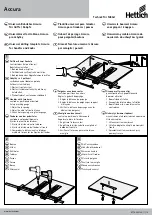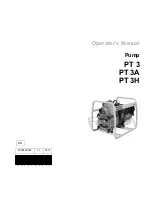
ENGLISH • 11
counter-clockwise.
2. Before replacing collet nut, check to make sure
the 1/8” collet is installed in the motor shaft.
Notes:
a) To change collet, see Fig. C.
b) Do not tighten collet nut on collet.
3. Pull flexible shaft inner cable (11) out of the outer
casing
(12) about 2”.
4. Insert flexible shaft inner cable into the collet until
the stopper (13) touches the collet.
5. Tighten collet nut (see Fig. D).
Note:
Do not use pliers to tighten the collet nut.
Use the small wrench supplied. Over tightening will
cause damage to the tool.
Note: Slide flexible shaft outer casing over the collet nut
until casing rests against the threaded section (14).
Note: DO NOT force the outer casing. If the outer
casing will not easily slide over the inner cable, turn
the collet on the opposite end of the flexible shaft until
the resistance of the inner cable ceases.
6. This should allow the outer casing to slide over
the inner cable, and then allow the casing to rest
against the threaded section.
7. Screw flexible shaft head nut (15) onto the threaded
section by turning it clockwise.
Note: Only finger-tighten spindle nut. Do not use
pliers or wrench.
Changing the collet and accessories
in the flexible shaft (Fig. F)
To change the collet or to install an accessory in the
flexible shaft, follow “Changing the collet” and
“Installing accessories”. To lock the shaft, pull back on
the flexible shaft grip (16) and rotate the collet until the shaft
grip locks the shaft (see Fig. F). The flexible shaft grip
will return to its normal position when not being held in
the lock position.
Notes:
a) Do not attempt to loosen or tighten the collet
without locking the shaft as noted above.
Damage to the flexible shaft will result.
b)
Do not over tighten collet nut.
Warning! When using the flexible shaft, only hold
the shaft by the grip. Do not force the cutting accessory
so as to avoid damaging the flexible shaft.
Assembling and installing the stand (Fig. G, H, I)
The C-clamp that holds the hang bar rod can be mounted
either horizontally or vertically (a) and (b).
1. Clamp the C-clamp (18) onto a work table (horizontal
surface) or other appropriate vertical surface by tightening
the clamp screw (17) clockwise (see, (a) and (b)).
Note: Do not over tighten to avoid breaking the clamp.
2. Thread screw (19) in the bottom of the hang bar rod (20)
into the appropriate mounting hole (21) in the C-clamp
(Fig. H).
Note: Do not over tighten. Hand-tighten only.
3. Loosen hang bar sections (22) by turning them
counter-clockwise.
4. Pull out each hang bar section approximately 5”
and lock into place by turning them clockwise.
Note: Do not over tighten. You will damage the locking
mechanism.
5. Insert the rotary tool hanger (23) into the top
of the hang bar rod.
6. Using the hang loop on the rotary tool (24) hang rotary
tool from the stand (Fig. I).
Selecting proper speeds
Different speeds are required depending upon the type
of operation being performed. The following chart outlines
those basic speeds:
OPERATION
SPEED
Cutting metal
Maximum
Sanding wood
Maximum
Cutting hard metal
Maximum
Engraving metal
Med-Max
De-burring
Med-Max
Drilling holes
Med-Max
Removing rust
Med
Sharpening
Med
Polishing
Slow
APPLICATION
Warning! To reduce the risk of injury, electric shock
and damage to the tool, before any work check the utility
lines electricity, gas or water supply line are hidden in the
work area.
Warning! Firmly grasp primary hold part of tool and
side handle before starting.
MAINTENANCE
Your tool has been designed to operate over a long period of
time with a minimum of maintenance. Continuous satisfactory
operation depends upon proper tool care and regular cleaning.
Warning! When servicing, use only identical replacement
parts. Use of any other part may create a hazard or cause
product damage.
DO NOT use solvents when cleaning plastic parts. Most
plastics are susceptible to damage from various types of
commercial solvents and may be damaged by their use.






























